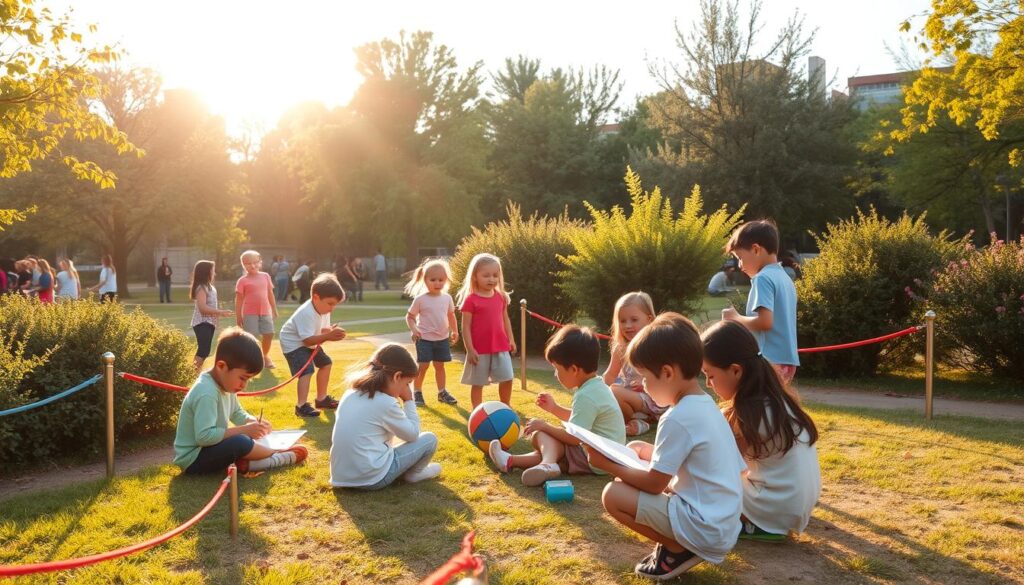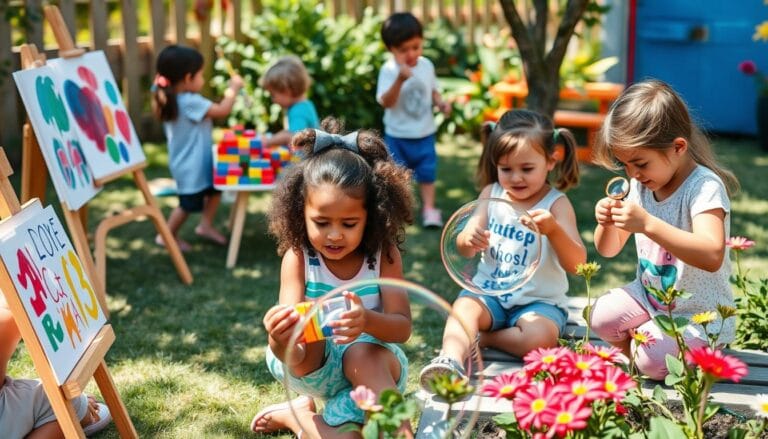
Setting Healthy Boundaries for Kids A Guide
Boundaries for Kids As parents, we naturally set basic rules for our kids, like not hitting or interrupting. But as they get older, they need to learn to set their own boundaries and respect others’. This means teaching them to be empathetic, self-aware, and able to express their feelings and needs.
Parents are key in showing kids how to set boundaries. By being good role models and teaching them how to set boundaries, we guide them in managing their relationships. Starting early and talking openly helps kids build strong boundaries for life.
Setting the right boundaries and using positive parenting can help kids understand and respect limits. This leads to better communication, higher self-esteem, and better emotional control. It’s important for parents to be consistent but also open to changing boundaries as kids grow.
Key Takeaways
- Start discussing Boundaries for Kids with children at a young age
- Model respectful behavior and effective boundary setting
- Encourage open communication and create a safe space for children to express themselves
- Use positive parenting techniques and age-appropriate discipline strategies
- Be consistent in enforcing boundaries while remaining flexible as children grow
Understanding the Importance of Boundaries for Children
Setting healthy boundaries for kids is key in parenting. These boundaries help kids know what’s okay and what’s not. They guide kids to act right and interact well with others. By setting clear rules, parents help kids feel safe, develop positively, and stay emotionally stable.
Defining Boundaries in the Context of Parenting
Parenting boundaries mean the rules and limits parents set for their kids. These rules cover many areas, like how kids behave, talk, and interact with others. Parenting expert L.R. Knost says healthy boundaries create a caring space for kids to grow and find their identity.
Studies show that the Authoritative Style of parenting works best. It means setting clear rules and being consistent while being warm and supportive. This way, kids learn the reasons behind rules and how to handle consequences.
The Role of Boundaries in Child Development
Boundaries are crucial for kids’ growth in many ways. Kids who have clear rules and consequences learn to respect boundaries. This skill helps them deal with social situations and build strong relationships.
Boundaries also help kids feel secure and stable. This is important for their brain development. Kids with the right boundaries learn to control themselves, make good choices, and handle their feelings better.
| Parenting Style | Characteristics | Impact on Boundaries |
|---|---|---|
| Authoritarian | Strict rules, little warmth | Children may rebel or struggle with self-regulation |
| Authoritative | Clear rules, consistent consequences, warmth | Children understand and respect boundaries |
| Indulgent | Few rules, high responsiveness | Children may struggle with self-control and decision-making |
Boundaries also boost kids’ overall well-being. By setting limits with love, parents show they care about their kids’ safety and happiness. This builds a strong bond, trust, and open communication.
“Boundaries are not about punishing a child for stepping out of line. They’re about teaching a child how to walk confidently and securely within the lines of safety and respect.” – L.R. Knost
In conclusion, boundaries are very important in parenting. They give kids the tools to succeed in a complex world. By enforcing boundaries with love and consistency, parents help their kids emotionally, support brain growth, and prepare them for a lifetime of good relationships and personal growth.
Identifying the Need for Boundaries
As a parent, it’s key to watch your child’s actions and your feelings. This helps you see when they need boundaries. Setting boundaries early helps your child learn good habits and feel safe and loved.
Common Signs That Your Child Needs Boundaries
Children show signs when they need boundaries. Some signs include:
- Pushing limits or testing rules
- Lacking self-control or being too impulsive
- Not respecting others’ space or things
- Seeking attention in ways that are not good
- Having trouble managing their feelings or frustration
When these signs don’t go away, setting clear boundaries is important. It helps your child know what’s expected and learn to control themselves. Studies show kids who learn about boundaries and consent are 43% less likely to take risks later.
Recognizing Your Own Feelings as a Guide
Your intuition and feelings are great guides for knowing when your child needs boundaries. Notice how you feel when your child acts out, like:
- Feeling annoyed, frustrated, or resentful
- Being overwhelmed or feeling too stretched
- Feeling guilty or worried about disappointing your child
- Feeling torn between pleasing your child and setting limits
These feelings often mean your child needs boundaries. By listening to these feelings, you and your child can feel better. Remember, setting boundaries is a way to show love and make your child feel safe and supported.
Parents who learn about setting healthy boundaries feel 68% more confident talking to their kids about tough topics.
By paying attention to your child’s actions and your feelings, you can spot when boundaries are needed. This helps create a caring space where your child can grow and feel good about themselves.
Differentiating Between Needs and Wants
As parents, it’s key to know the difference between needs and wants for our kids. We must make sure their basic needs like food, sleep, safety, and emotional support are met. But, it’s also important to set limits on their desires. This helps them learn self-control and how to handle disappointment.
Studies show that giving kids choices within limits helps them learn important life skills. When they make decisions within a framework, they feel empowered and responsible. But, too many choices without limits can cause frustration and power struggles.
Child development experts say young kids test boundaries to understand the world. They act like little scientists, learning about limits and consequences. Setting clear boundaries gives them a sense of security and stability.
When boundaries are unclear, kids may act out to seek validation and test limits. In these cases, parents should stay calm and firm, reaffirming the boundaries with love. The article “Setting Healthy Boundaries for Kids” highlights how important this is for their well-being.
“Discipline is not a dirty word. I think the real shame is not having any expectations of our children, not setting appropriate limits, or not teaching the difference between right and wrong.” – Alina Tugend, author of “Better by Mistake”
Understanding the difference between needs and wants is vital for setting boundaries. By meeting their needs and teaching them to manage desires, we prepare them for life. With consistent, loving guidance and clear boundaries, we build their security, empowerment, and resilience.
| Needs | Wants |
|---|---|
| Nutritious food | Candy and sweets |
| Adequate sleep | Staying up late |
| Safety and security | Engaging in risky behaviors |
| Emotional support | Constant entertainment |
| Education | Skipping school |
By understanding needs and wants, we empower our kids to make responsible choices. This helps them face life’s challenges with confidence and resilience.
Establishing Clear and Consistent Boundaries for Kids
As parents, we play a key role in guiding our kids to grow up healthy. We do this by establishing clear boundaries. Kids from 18 months to 5 years start to learn about limits. Setting consistent boundaries gives them security and helps them grow.
When talking about communicating boundaries, we must do it with love and affection. Using the four C’s of healthy boundaries helps us. This means being clear, confident, comfortable, and connecting with our kids.
The Four C’s of Healthy Boundaries: Clear, Confident, Comfortable, and Connecting
To set good boundaries, we need to be clear and simple. Our language should be easy for kids to understand. Being confident shows we believe in the boundary.
Feeling comfortable helps create a positive setting. It makes kids feel safe and respected. Connecting with them emotionally shows that boundaries come from love and affection, not punishment.
“Boundaries are not meant to be barriers; they are meant to be bridges that connect us to our children in a meaningful way.”
Communicating Boundaries with Love and Affection
When communicating boundaries, our goal is to support our kids’ growth. Doing it with love and affection makes the environment positive. This encourages kids to cooperate and understand.
- Using a calm, gentle tone of voice
- Offering clear explanations for why the boundary is important
- Acknowledging and validating our children’s feelings
- Providing positive reinforcement when boundaries are respected
Studies show that positive feedback is better for good behavior. By always using love and affection when setting boundaries, we build a strong bond. This bond helps our kids in many ways as they grow up.
| Age Group | Boundary Focus | Communication Strategies |
|---|---|---|
| Toddlers (18 months – 3 years) | Safety, basic needs, simple rules | Short, clear phrases; gentle physical guidance; positive reinforcement |
| Preschoolers (3 – 5 years) | Routines, social skills, emotional regulation | Explanations, choices within limits, consistent consequences |
As parents, we can shape our kids’ view of boundaries. By establishing clear, consistent boundaries and talking about them with love and affection, we give them a strong start. This helps them grow up healthy and confident.
Handling Resistance and Pushback from Children
As a parent, it’s normal for kids to resist and push back when you set boundaries. Dr. Gordon Neufeld says this is because kids want to protect themselves when they feel controlled. Even kids who love their parents can still show resistance.
When kids resist, it’s key to stay calm and firm. The more you try to force them, the more they’ll fight back. This can make kids feel insecure and anxious. Instead, focus on building a strong bond with your child. This makes them more willing to listen and follow your guidance.
Expecting and Accepting Pushback as Normal
Many parents worry about conflict when setting limits. But, conflict is a part of growing and learning. It’s normal for kids to test limits and challenge rules. By accepting this, you can handle these moments better.
| Strategy | Description |
|---|---|
| Focus on connection | Prioritize maintaining a strong bond with your child to reduce resistance |
| Reduce coercion | Avoid using phrases like “You have to,” “You must,” or “You need to,” as they elevate the counterwill instinct |
| Take breaks | Step back from counterwill battles and revisit the issue when the attachment is stronger to prevent relationship damage |
| Involve children in decision-making | Allow children to have their own ideas and initiative to reduce resistance |
| Make amends | If distance is created due to counterwill battles, make amends to restore the relationship |
Staying Calm and Firm in the Face of Resistance
When kids resist, it’s up to the adult to stay calm and firm. Be ready for a meltdown, but don’t give in. Sometimes, kids push back because they’re looking for a way to release their feelings.
Setting limits was noted as relatively manageable, but enforcing them, especially in moments of conflict when children push back, poses a significant challenge for parents.
By staying calm and consistent, you help your child grow and become more independent. Remember, dealing with resistance is a learning journey for both you and your child. With patience and understanding, you can create a loving and supportive home.
Modeling Healthy Boundaries as a Parent
As parents, we set the example for our kids. Teaching them about healthy boundaries is key. By showing respect for our own limits, we teach them about self-care and connection. Remember, we all make mistakes, and learning from them is part of the journey.
Before we help our kids, we need to check our own limits. Setting boundaries with kids is about our limits too. By listening to our feelings and sharing them, we build respect and understanding. A study shows that showing respect for others’ space teaches kids about boundaries.
Dealing with tough situations means taking care of ourselves. Knowing we have limits helps kids see we’re okay with our choices. Teaching kids to set boundaries early helps them trust themselves and others.
“The most effective way to teach children about boundaries is to model them ourselves. When we respect our own limits and communicate them clearly, we create a foundation of trust and understanding that our children can build upon.”
Setting clear rules and explaining them helps kids understand boundaries. This way, they learn to respect others and safety. By showing respect for others’ space, we help kids build positive relationships.
Self-care is not selfish; it’s essential for good parenting. By taking care of ourselves and setting healthy boundaries, we teach kids important skills. As we face parenting challenges, let’s connect with our kids, guiding them with love and clear boundaries.
Adapting Boundaries as Children Grow and Develop
As kids grow, parents need to adjust how they set boundaries. This helps kids become independent, responsible, and emotionally smart. Studies show that teaching kids about boundaries helps them get along better with others.
Age-Appropriate Boundaries for Toddlers and Preschoolers
Toddlers and preschoolers need clear rules. They’re learning to control their feelings and actions. Experts say setting boundaries early helps kids talk about their feelings better.
Parents can set good boundaries by:
- Creating a daily routine
- Using simple language to explain rules
- Positive feedback for good behavior
- Limiting screen time
Evolving Boundaries for School-Age Children and Teens
As kids get older, boundaries need to change. They want more freedom and privacy. Kids who learn about boundaries early are more empathetic, which helps in making friends.
Parents can adjust boundaries by:
- Letting kids help make rules
- Encouraging talking and listening
- Giving them choices
- Talking about social media and online safety
Research shows kids with clear boundaries make better choices and are more independent. By changing boundaries as kids grow, parents help them develop important life skills. For more on teaching kids emotional intelligence, check out Building Emotional Intelligence 2.0 in.
| Age Group | Key Boundary Considerations | Benefits |
|---|---|---|
| Toddlers and Preschoolers | Consistency, clear communication, positive reinforcement | Improved emotional communication skills |
| School-Age Children | Collaborative rule-setting, open communication, age-appropriate autonomy | Increased empathy and social skills |
| Teens | Expectations for social media use, online safety, independence within limits | Enhanced decision-making skills and independence |
Setting limits on screen time can reduce family fights by 25%. By adjusting boundaries, parents help kids develop emotional smarts, self-control, and strong relationships.
Fostering Empathy and Respect Through Boundaries
As parents, we play a key role in teaching our kids empathy and respect. By teaching about boundaries, we help them become caring and thoughtful people. They learn how their actions affect others.
Child psychologists say kids as young as three can show concern for a friend in distress. They can also understand when someone is uncomfortable. This shows they have an early start on empathy. By talking to kids about how others might feel, we help them connect actions with emotions.
Teaching Children to Respect Others’ Boundaries
HeartMindOnline says it’s crucial to teach kids the value of respecting personal boundaries. This helps them stand up for themselves when boundaries are crossed. Parents can show kids how to respect others by being empathetic themselves. This can be done in several ways:
- Real-time coaching that addresses boundary-infringing behaviors as they happen
- Using media content, such as TV shows or books, as a teaching tool to discuss empathy and boundary-setting examples
- Encouraging children to interact with a diverse group of peers from different backgrounds, races, and abilities to enhance their empathy and understanding of boundaries
“Children who comprehend why it is detrimental to intrude on someone’s personal space without permission are more likely to respect others’ boundaries and voice their own.” – HeartMindOnline
Encouraging Children to Set Their Own Boundaries
It’s just as important to teach kids to set their own boundaries. This empowers them to protect themselves and make choices about their well-being. Here are some strategies to help:
| Strategy | Benefit |
|---|---|
| Active listening and perspective-taking | Helps children feel heard and understood, fostering trust and open communication |
| Role-playing and scenario-based activities | Allows children to practice setting boundaries effectively and make decisions about their well-being |
| Providing a safe and supportive environment | Encourages children to express their feelings and concerns, developing emotional resilience and a sense of security |
| Collaborating with parents and guardians | Reinforces boundary-setting practices at home, ensuring a consistent approach |
Teaching empathy and boundaries is a continuous effort that grows with our children. By instilling these values early, we shape them into compassionate adults. They learn to consider the impact of their actions on others.
Conclusion
Setting healthy Boundaries for Kids is key in positive parenting and child development. It helps create a safe space for kids to grow emotionally, socially, and cognitively. By talking respectfully and showing how to set boundaries, kids learn empathy and how to respect others.
As kids get older, parents need to adjust how they set boundaries. Teaching kids to speak up for themselves is important. This helps them deal with bullying, peer pressure, or uncomfortable situations.
Role-playing and games like “Red Light, Green Light” can help kids practice setting boundaries. This boosts their confidence and prepares them for real-life challenges.
Teaching kids about boundaries is essential for healthy relationships and communication. It helps them develop self-confidence and learn to express their needs. By focusing on emotional intelligence and setting healthy boundaries, parents help their kids thrive in a complex world. This is all explained in this guide to digital citizenship for kids.















